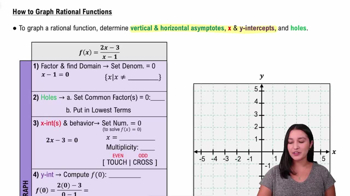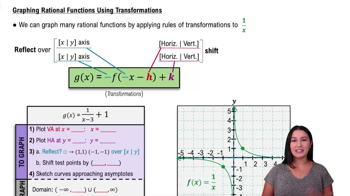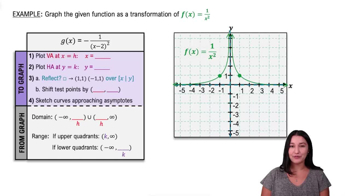Table of contents
- 0. Review of Algebra4h 16m
- 1. Equations & Inequalities3h 18m
- 2. Graphs of Equations43m
- 3. Functions2h 17m
- 4. Polynomial Functions1h 44m
- 5. Rational Functions1h 23m
- 6. Exponential & Logarithmic Functions2h 28m
- 7. Systems of Equations & Matrices4h 6m
- 8. Conic Sections2h 23m
- 9. Sequences, Series, & Induction1h 19m
- 10. Combinatorics & Probability1h 45m
5. Rational Functions
Graphing Rational Functions
Problem 64
Textbook Question
In Exercises 57–64, find the vertical asymptotes, if any, the horizontal asymptote, if one exists, and the slant asymptote, if there is one, of the graph of each rational function. Then graph the rational function. g(x) = (4x^2 - 16x + 16)/(2x - 3)
 Verified step by step guidance
Verified step by step guidance1
Identify the vertical asymptotes by setting the denominator equal to zero: \(2x - 3 = 0\). Solve for \(x\).
Determine the horizontal asymptote by comparing the degrees of the numerator and the denominator. Since the degree of the numerator (2) is greater than the degree of the denominator (1), there is no horizontal asymptote.
Check for a slant (oblique) asymptote because the degree of the numerator is exactly one more than the degree of the denominator. Perform polynomial long division of \(4x^2 - 16x + 16\) by \(2x - 3\).
The quotient from the division will give the equation of the slant asymptote.
Graph the rational function using the information about the asymptotes and any intercepts found during the process.
Recommended similar problem, with video answer:
 Verified Solution
Verified SolutionThis video solution was recommended by our tutors as helpful for the problem above
Video duration:
10mPlay a video:
Was this helpful?
Key Concepts
Here are the essential concepts you must grasp in order to answer the question correctly.
Vertical Asymptotes
Vertical asymptotes occur in rational functions where the denominator equals zero, leading to undefined values. To find vertical asymptotes, set the denominator of the function to zero and solve for x. These asymptotes indicate values that the function approaches but never reaches, resulting in a vertical line on the graph.
Recommended video:

Determining Vertical Asymptotes
Horizontal and Slant Asymptotes
Horizontal asymptotes describe the behavior of a function as x approaches infinity or negative infinity, indicating the value the function approaches. For rational functions, if the degree of the numerator is less than the degree of the denominator, the horizontal asymptote is y=0. A slant (or oblique) asymptote occurs when the degree of the numerator is exactly one more than that of the denominator, found through polynomial long division.
Recommended video:

Determining Horizontal Asymptotes
Graphing Rational Functions
Graphing rational functions involves plotting key features such as intercepts, asymptotes, and behavior at infinity. Understanding the locations of vertical and horizontal/slant asymptotes helps in sketching the overall shape of the graph. Additionally, identifying x-intercepts (where the numerator equals zero) and y-intercepts (where x=0) provides critical points for accurate graph representation.
Recommended video:

How to Graph Rational Functions

 5:31m
5:31mWatch next
Master Graphing Rational Functions Using Transformations with a bite sized video explanation from Callie
Start learningRelated Videos
Related Practice



